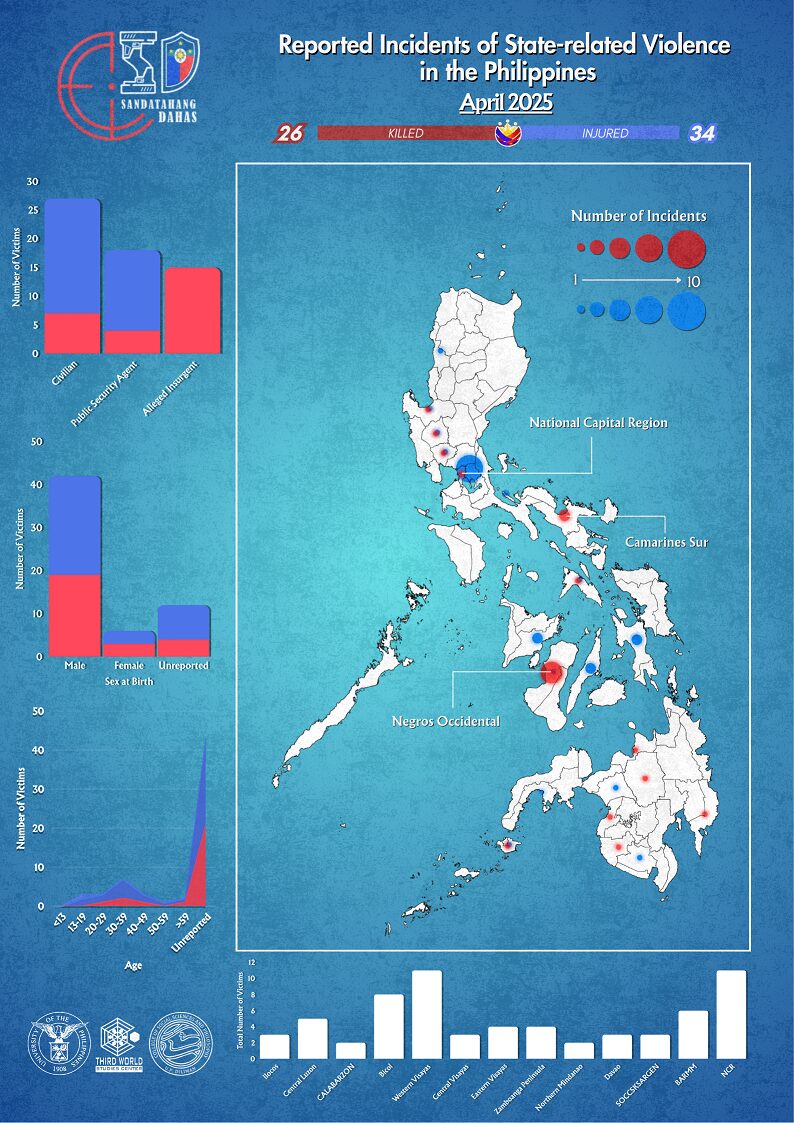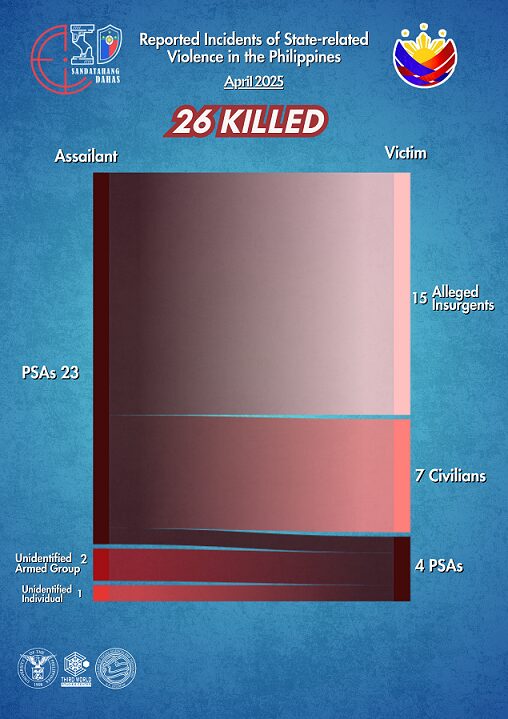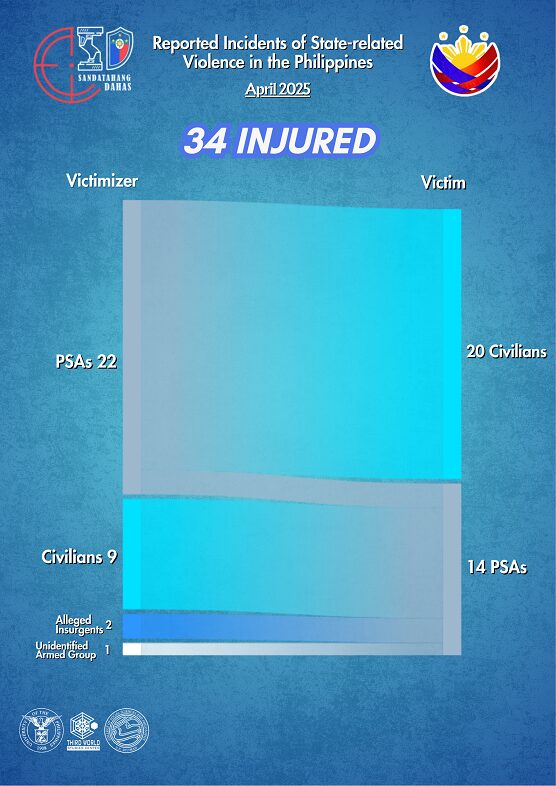The state-related violence recorded by the Sandatahang Dahas monitor shifts its epicenter from Mindanao to Luzon, with the National Capital Region leading with 11 cases.

There were 60 victims of state-related violence in April—26 killed and 34 injured—fewer than those in the previous month (74). Since January, the government armed personnel remain the leading perpetrators by a large margin for most of these incidents.

Four of the 26 fatalities were recorded among the ranks of law enforcement agents: two each from the Armed Forces of the Philippines (AFP) and the Philippine National Police (PNP).
Fifteen members of the New People’s Army (NPA) were also killed in operations by the state army. Most notably, an anti-insurgency operation of the 302nd Infantry Brigade and 3rd Infantry Division in Barangay Tapi, Kabankalan City, Negros Occidental led to the death of seven alleged NPA members, including three high-ranking cadres namely Reniel “Kupol/Adie” Locsin Cellon, Mary Jane “Shonie/Chinchin/Shedi” Maguilat, and Charity “Cha/Leah/Nanay/Nelma/Cara” Amacan. Jhon “Dahlia/Gabby/Ellians/Steph” Isidor Supelanas, a transwoman, was also among them. A civilian reported to be with a disability was also wounded by a stray bullet during the incident.
Seven civilians were also killed this month. One of them was killed during a Philippine Drug Enforcement Agency (PDEA) operation on April 9, while another was during a joint operation between the Marine Battalion Landing Team-5, PNP, and other security agencies last April 18.
For the fourth consecutive month, operations of police and military forces remain as the primary circumstance that led to the killings of 15 alleged insurgents and 5 civilians. Fifteen deaths during these operations were attributed to the AFP, three to the police, one to the PDEA, and one to a joint operation conducted by the AFP and PNP.
Cases of government armed personnel harming another officer within their camp continue. In January, a soldier was killed by another soldier inside their camp in Bohol. This month, an incident triggered by a conflict between two PNP Special Action Force (PNP-SAF) officers over laundry hung inside their quarters’ comfort room in Camarines Sur led to the death of Patrolman Rodel Abelido of the 92nd Special Action Company of PNP-SAF’s 9th Special Action Battalion by a gunshot wound in the head.
Another incident of attack against a policeman was reported in Sta. Barbara, Pangasinan. On April 19, a member of an inter-operative and drug enforcement team was shot while riding a motorcycle by an unidentified gunman-rider. The victim was rushed to the hospital, but lost his life on April 23.
There were also reports of a notable case in Basilan where an unidentified armed group ambushed and killed two and injured another who were part of 18th Infantry Battalion of Philippine Army while they were on motorcycles on the way to their command base in Barangay Lahi-Lahu, Tuburan.
Of these incidents of killings, 23 were committed by government armed forces: 15 by the Philippine Army, 6 by the PNP, 1 by the PDEA, and 1 by a joint operation between the Philippine Navy and PNP. Furthermore, 2 killings were perpetrated by an unidentified armed group, and 1 by an unidentified individual.
Males remain the majority of the victims: 19 of them were killed. Among them, one identified as a transwoman according to reports. This number is followed by 4 victims with unreported sex, and 3 females.

A total of 34 injuries were also recorded in April 2025, 20 of whom were civilians. Of note was an incident involving a barangay peace and safety officer and a member of the Citizen Armed Force Geographical Unit (CAFGU) in General Nakar, Quezon. The suspect was reportedly looking for his live-in partner when he saw her with the victim inside a barangay councilor’s house. Armed with an M16 rifle, the suspect shot him in the thigh.
The remaining 14 injuries recorded this month involved government armed personnel. In Cebu City, in two incidents, the police injured civilians. On April 7, an off-duty police officer was arrested for allegedly assaulting and threatening a civilian with firearms without any clear reason. The officer is now being held at the Guadalupe Police Station and is facing charges of grave threat and physical injuries, where the case is ongoing. On April 8, a SWAT team responded to a report of a hotel security guard who ran amok. The responding team shot him in the leg. However, a police officer was also left injured after a bullet he fired to subdue the suspect ricocheted and hit him.
Election-related injuries were also recorded this month. On April 10, a confessed drug lord and now Albuera, Leyte Mayor-elect Rolan Eslabon “Kerwin” Espinosa was allegedly shot by a police officer during a campaign event in Barangay Tinagan, Albuera, Leyte. Two other civilians were also injured in the incident including a minor.
In another incident on April 20, Aladin “Alden” Minggoy, a fisherman and a supporter of Claveria, Masbate’s Mayor-elect Karen Ballesteros, was gunned down by a police bodyguard of Claveria’s incumbent Mayor Froilan Andueza. Minggoy had just finished eating with his fellow supporters inside a barangay councilor’s home when the mayor’s group arrived and one of the bodyguards pulled out a long gun. The victim immediately noticed the act and was able to hide inside a nearby home for three hours. The gunman also reportedly shot the house where Minggoy hid, igniting an altercation between the two. Later on, Minggoy was shot by the policeman on his stomach using a .45 caliber pistol.
Police continue to contradict their motto of “to serve and protect” with their displays of abuse of authority.
Among the victims of PNP in this month’s monitor was Winifredo “Arvin” Pedroso Nim Sr., who allegedly violated the RA 10591 or the Comprehensive Firearms and Ammunition Regulation Act. Police officers reportedly went to Arvin’s house in Arakan, Cotabato to serve a search warrant where he shot the investigating authorities, leading to an exchange of fire between them. However, one of Arvin’s children claimed that the police failed to show a search warrant to her father. The police, nevertheless, asserted that the operation held last April 25 was legitimate.
Last April 23, S/Sgt. Colonel Jordan Marzan of Masambong Police Station 2 allegedly broke into a home in Quezon City while under the influence of alcohol. He reportedly assaulted a minor and injured two other individuals. In a statement, PNP Chief Rommel Marbil said there will be no leniency for those who harm the people they swore to protect. Marzan has since been disarmed and now faces multiple charges and complaints for violation of domicile, slight physical injuries, grave threat, and violation of Republic Act 7610, the Special Protection of Children Against Abuse, Exploitation, and Discrimination Act.
As with the deaths this month, the majority of those injured were male (23), followed by persons whose sex was unreported (8), then females (3).
The April 2025 Sandatahang Dahas report reveals distinct regional patterns driven by multiple variables such as anti-insurgency operations, election-related tensions, police misconduct, intra-force conflicts, and localized disputes across Luzon, Visayas, and Mindanao.
Similar to previous months, the Armed Forces of the Philippines (AFP) and the Philippine National Police (PNP) were the primary perpetrators, with males comprising the majority of victims. Each region’s unique profile—Luzon’s urban concentration, Visayas’ insurgency-election nexus, and Mindanao’s scattered multifarious violence—highlights systemic issues in state security practices and their implications for the 2025 Philippine midterm elections.
Luzon led with 10 fatalities and 19 injuries, centered in the National Capital Region (NCR) with 11 cases (10 injuries, 1 fatality), driven by police misconduct and force operations. Notable incidents include S/Sgt. Colonel Jordan Marzan’s alleged assault on a minor in Quezon City and an intra-force killing in Camarines Sur, where Patrolman Rodel Abelido was shot over a dispute about laundry. PNP-led force operations caused seven deaths and 12 injuries, with scattered cases in Pampanga, Pangasinan, Tarlac, Quezon, and Ilocos Sur tied to election tensions and personal disputes.
Visayas reported eight fatalities and 10 injuries, primarily from anti-insurgency operations and election-related violence. Negros Occidental saw seven insurgency-related deaths in an AFP-NPA clash, with a civilian injured by a stray bullet. Election violence in Leyte injured Mayor-elect Rolan Eslabon “Kerwin” Espinosa and two civilians, including a minor. Seven policemen identified as “persons of interest” in the incident were charged with illegal possession of firearms and violation of the election gun ban. Espinosa has also filed frustrated murder complaints against them. On the other hand, Cebu’s cases involved PNP misconduct, like an off-duty officer’s assault. PNP operations in the island caused six injuries.
Mindanao’s eight fatalities and five injuries were scattered across Basilan, Cotabato, Davao Oriental, and other provinces, driven again by anti-insurgency, drug-related operations, and localized disputes. Basilan’s AFP ambush and Cotabato’s disputed PNP operation against Winifredo Pedroso reflect state-driven triggers. The injuries were also mainly caused by state actors from the PNP, the AFP, and the PDEA. Mindanao’s data suggests a decentralized pattern of violence, reflecting Mindanao’s complex socio-political landscape, with lethal, targeted incidents signaling persistent instability.
The authors are interns at the Third World Studies Center, College of Social Sciences and Philosophy, University of the Philippines Diliman. Graphics by John Matthew A. Cabural and Aidrielle Raymundo. To learn more about Sandatahang Dahas, visit its website: https://dahas.upd.edu.ph/sandatahang-dahas/ and for the latest updates, follow the Dahas Project in these social media platforms: https://x.com/DahasPH, https://www.instagram.com/dahas.project/, https://www.threads.net/@dahas.project, and https://bsky.app/profile/dahasph.bsky.social. Reports for the previous months are available at https://dahas.upd.edu.ph/sd-monthly-reports/.